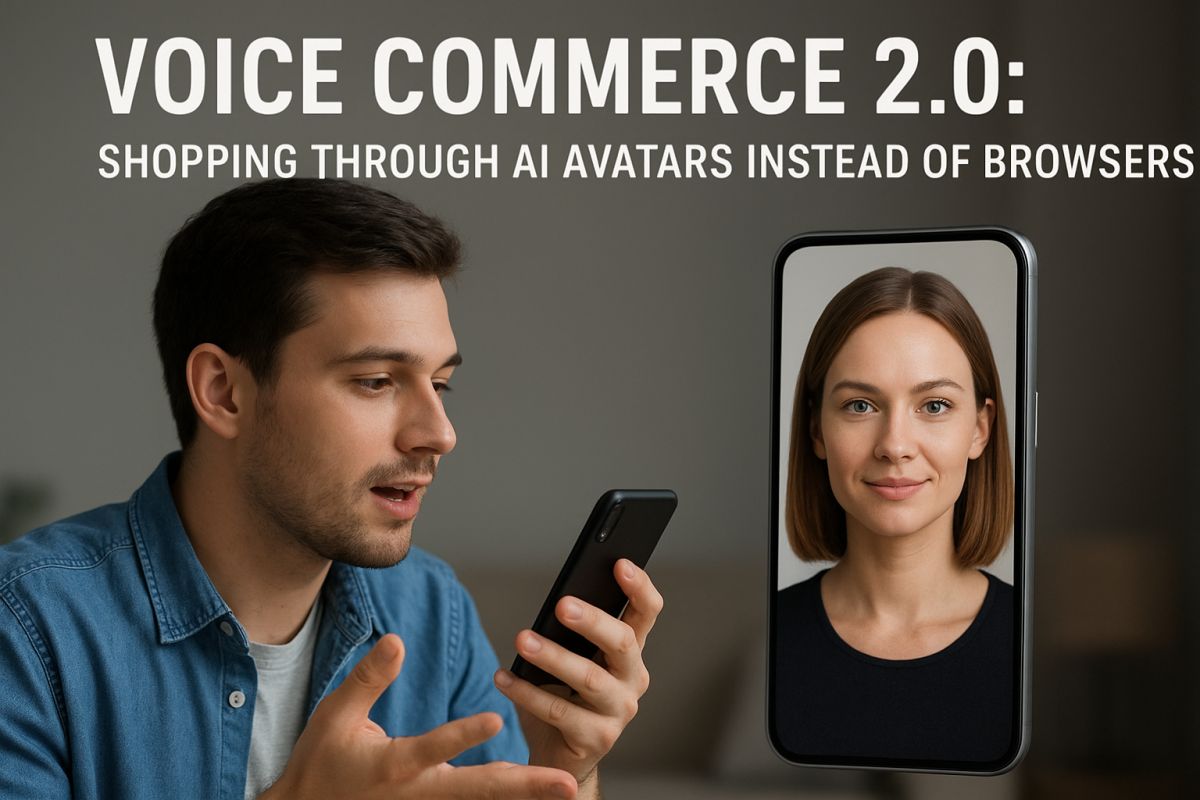Voice Commerce 2.0: Shopping Through AI Avatars Instead of Browsers

Voice Commerce 2.0 is the next evolution of online shopping, where AI-powered avatars replace traditional web browsers. Instead of typing on search engines or scrolling through product pages, users can simply talk to their AI assistant, describe what they want, and the avatar will find, compare, and even complete purchases on their behalf. This shift makes shopping faster, more intuitive, and personalized, signaling a big step forward from voice search into voice-driven transactions.
The Evolution of Voice Commerce
Voice commerce is not brand new. It began with smart speakers like Amazon Alexa, Google Assistant, and Apple’s Siri, which allowed users to add products to a cart or check prices using voice commands. But those experiences were often limited, clunky, and not truly conversational.
Voice Commerce 2.0 changes the game:
- AI avatars can understand complex requests (e.g., “Find me a sustainable coffee brand under $20, with good reviews, and fast delivery”).
- They provide visual feedback through digital avatars instead of flat text results.
- Purchases happen seamlessly, with avatars completing the transaction within the ecosystem—no need to open a browser or app.
How AI Avatars Work in Shopping
AI avatars in Voice Commerce 2.0 are more than just assistants—they act as personal digital shoppers.
1. Natural Conversations
You interact with them like a human shopping guide. For example:
“I need a birthday gift for my sister. She likes books, skincare, and tech gadgets under $50.”
The avatar analyzes your request, scans product databases, and suggests the most suitable options.
2. Visual + Voice Integration
Unlike old voice-only systems, AI avatars now appear in 3D or 2D digital forms across devices. They show product images, highlight deals, and explain pros and cons in real-time.
3. Personalization
Avatars remember your shopping history, preferences, budgets, and even delivery addresses. This allows for tailored recommendations that improve with each interaction.
4. Seamless Transactions
Instead of redirecting you to a website, AI avatars integrate with payment systems and logistics providers to complete the purchase instantly.
Benefits of Voice Commerce 2.0
Hands-Free Convenience
Users no longer need to scroll through hundreds of products or switch apps. A simple conversation gets the job done.
Faster Decision-Making
AI avatars compare products across multiple sellers, saving time and reducing the need for manual research.
Hyper-Personalized Shopping
Avatars learn individual tastes, making shopping experiences feel curated, almost like having a personal stylist or assistant.
Accessibility
Voice commerce makes online shopping easier for people with disabilities, elderly users, and those less comfortable with technology.
Reduced Screen Fatigue
With avatars managing browsing and comparisons, users spend less time staring at screens.
Challenges and Concerns
Like any new technology, Voice Commerce 2.0 has challenges that businesses and users should be aware of:
- Privacy Risks: AI avatars handle sensitive personal and payment data, raising security concerns.
- Over-Personalization: If algorithms narrow choices too much, users may miss out on discovering new brands.
- Trust Factor: Shoppers may hesitate to allow an avatar to make high-value purchases without manual confirmation.
- Adoption Gap: Not all consumers or businesses are ready to move away from browser-based shopping.
Voice Commerce 2.0 vs. Traditional Browsing
| Feature | Voice Commerce 2.0 | Traditional Browsers |
|---|---|---|
| Interaction | Conversational voice + avatar | Text-based search + clicks |
| Speed | Faster, instant comparison | Slower, manual navigation |
| Personalization | Highly personalized | Limited (cookies, ads) |
| Convenience | Hands-free, seamless checkout | Multiple steps, manual input |
| Visual Support | Avatars with visual feedback | Standard product listings |
Real-World Applications of AI Avatars in Shopping
- Retail Giants – Amazon, Walmart, and Alibaba are experimenting with AI-driven shopping assistants to streamline checkout.
- Fashion Industry – AI avatars can suggest outfits, sizes, and accessories based on user preferences.
- Grocery Shopping – Avatars can automatically reorder essentials like milk, bread, and vegetables on schedule.
- Travel & Lifestyle – Instead of browsing travel sites, users can ask avatars: “Find me a weekend getaway under $300, with a beach view.”
- B2B Commerce – Businesses can order supplies via voice commands, saving time on procurement processes.
The Future of Voice Commerce 2.0
Experts believe AI avatars will soon:
- Integrate with AR/VR shopping (try products virtually with your avatar’s help).
- Negotiate deals on your behalf (avatars haggling with vendor AI bots).
- Work across devices (from smartwatches to car dashboards).
- Evolve into digital clones—avatars that mirror your tastes so well they shop exactly as you would.
In the next 5–10 years, browsers may no longer be the main shopping tool. Instead, AI-driven avatars could become the default interface for e-commerce.
How Businesses Can Prepare
- Optimize for Voice Search – Move beyond text SEO and ensure product data is compatible with natural language queries.
- Adopt AI Shopping Assistants – Retailers should consider integrating AI avatars into their platforms.
- Focus on Personalization – Collect user insights responsibly to offer tailored experiences.
- Strengthen Security – Ensure voice transactions are encrypted and compliant with data protection laws.
- Educate Consumers – Build trust by showing users how AI avatars make shopping easier and safer.
Conclusion
Voice Commerce 2.0 represents a revolution in online shopping, moving from clicks and scrolls to conversations with AI avatars. Instead of spending hours browsing, users can now let AI-driven assistants find, compare, and complete purchases instantly. While challenges around privacy, trust, and adoption remain, the opportunities for faster, smarter, and more personalized shopping are enormous. Businesses that embrace this shift early will be better positioned for the AI-driven future of e-commerce.









